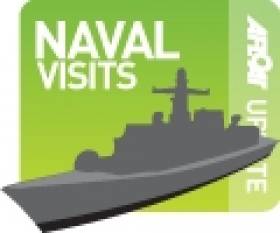Displaying items by tag: Poolbeg Marina
Navies from EU Member States On Visit to Dublin Port
#navalvisitors - Navies from three EU member states have become the first foreign naval visitors of the year to call to Dublin Port having taken up berths since mid-week, writes Jehan Ashmore.
Over the previous two days, French, British and Dutch navies in that order have arrived to the capital and which has led to berths occupied at Ocean Pier, the marina at the Poolbeg Y&BC and at the North Quay Wall Extension. Next to the pier's Extension is the Tom Clarke (East-Link) bridge from where it should be possible to view all five visiting vessels.
As these naval vessels have occuppied berths within the more secure corden of the port's main estate located beyond the East-Link, they will not be open to public visits. Subsequent naval visitors, however may instead arrive to berth upriver along the Liffey Quays and hold public tours (or not as the case can be). Along this river bank is Sir John Rogersons Quay where such tours have been held and is convenient for the public to access given the close proximity of the capital's centre.
On this current call of naval visitors, the berth at Ocean Pier is where the French Navy's high-sea patrol vessel Premier maître l'Her is docked. The corvette is of the Estienne d'Orves class. Among its armoury is a SIMBAD anti-aircraft missile system. A sister Lieutenant de vaisseau Le Hénaff visited the port in 2017 but on that occasion headed upriver to berth along Sir John Rogersons Quay as pictured above.
Opposite of Ocean Pier on the south bank of the Liffey is the Poolbeg Marina, where the UK's Royal Navy presence consists of a trio of P2000 Archer class fast inshore patrol boats. The leadship of the class HMS Archer is joined by HMS Example and HMS Explorer.
These small craft provide training and maritime experience for University Royal Naval Unit students. In addition the URNU also provide support to wider Fleet tasking and exercises around the UK and Europe waters.
As for the waters of Dublin Port, the Royal Nederlands Navy is represented on this visit by HNLMS Van Speijk. This is the last ship of eight Karel Doorman-class multi-purpose frigates serving the Dutch navy and which was commissioned in 1995. Likewise of the French visitor, this frigate includes missiles in the form of the Sea Sparrow system.
Hollywood Star's Former Yacht Berths In Dublin
Poolbeg Yacht Club & Marina. Yacht & Boat berths & Storage in Dublin
Poolbeg marina offers 100, fully serviced, secure berths for motor and sail boats up to 20 metres. With a marina basin of 2.4 metres OD there is sufficient depth for most vessels at all stages of the tide. On shore, marina users are able to relax and enjoy the facilities of the new clubhouse. Constructed to international standards, the marina comprises secure access gates with CCTV, gangway, floating pontoons and breakwater units moored on the renowned seaflex mooring system. Services to each marina berth will include water, electricity and telecoms (CAT 5). Pump-out and diesel fuel facilities are also available. Whether you are a serious sailor looking for a secure marina berth in the heart of Dublin or you are seeking an alternative experience of the fair city, Poolbeg Yacht, Boat Club & Marina in the heart of Dublin is an experience not to be missed. Just a short walk from the city centre, Poolbeg marina offers stunning views of the River Liffey, the Dublin Docklands, and Port area.
Poolbeg Yacht, Boat Club & Marina, South Bank, Pigeon House Road, Ringsend, Dublin 4, Ireland.
Telephone: +353 (0)1 668 9983 Facsimile: +353 (0)1 668 7177
Email: [email protected]
Merseyside based UK Patrol Boat Berths in Dublin Marina
#NAVY VISIT – The Royal Navy's coastal training patrol boat HMS Charger (P 242) spent last night in Dublin Port having sailed from Liverpool's East Brunswick Dock. The vessel is based at the Commanding Officer of the Liverpool University Royal Naval Unit RN Headquarters on Merseyside, writes Jehan Ashmore.
The small boat measuring 20m in length and a beam of 6m remains this evening moored alongside the Poolbeg Yacht Boat Club Marina. The 100-berth facility faces Alexandra Basin where P&O Cruises Arcadia docked today.
HMS Charger is an Archer P2000 class patrol boat built by Waterfcraft Ltd of Shoreham. She provides practical navigation and seamanship training at sea where a crew recruitment unit takes place annually in early October from the universities in Liverpool and also from Lancaster University.
Last week HMS Charger called to Belfast Lough which included berthing in the city's Abercorn Marina basin next to the Titanic Quarter. Also visiting the basin this week was the newbuild WFSV Gardian 10 completed by Arklow Marine Services which was on a promotional delivery voyage to Great Yarmouth.
#LECTURES – Les Glénans Irish Seceur's final lecture of the winter series is titled 'The Viking Ship Warriors in Ireland New Discoveries'. John Mass will present the talk about the first Viking raids and settlement in 8th and 9th century Ireland.
The talk takes place next Tuesday, 29th May starting at 20.00hrs at the Poolbeg Yacht & Boat Club Marina in Ringsend, Dublin Port. Tickets cost €5 in aid of the RNLI.
Lecture: ''Madcap'' Me and Other Mad Wans
#LECTURES – The Dublin Bay Old Gaffers Association (DBOGA) last talk of the winter series is 'Madcap, Me and Other Mad Wans' which takes place next Thursday 22nd March (8pm) in Poolbeg YBC, Ringsend.
Adrian Spence, owner skipper of 'Madcap' will present an entertaining talk about his voyage to Greenland. Madcap, built in 1875, is the oldest of the Bristol Channel Pilot Cutters still sailing and is to be found nowadays in the Northern Ireland Old Gaffers fleet.
All are welcome to the evening with proceeds going to the RNLI. For further information about the DBOGA click HERE and the PYBC visit www.poolbegmarina.ie
Lecture: Diesel Engine Care & Maintenance
#LECTURES – The winter talk's series organised by the Dublin Bay Old Gaffers Association (DBOGA) continues at the Poolbeg Yacht and Boat Club, Ringsend, Dublin.
This month's lecture entitled 'The Second Chapter –On Diesel Engines Care and Maintenance' presented by Sean Walsh is to be held next Tuesday 17th January, starting at 8 pm. All are welcome to the evening with proceeds going to the RNLI.
In total there are five talks in the winter/spring 2011-2012 program, which started last October and will run to March. For further information about the DBOGA click HERE and the PYBC visit www.poolbegmarina.ie
Lecture: 'Searching for Saints-Skelligs to Iceland'
#LECTURES-Paddy Barry will be presenting "Searching for Saints –Skelligs to Iceland" the second of five Winter talks in a programme organised by the Dublin Bay Old Gaffers Association (DBOGA). The talk takes place this Tuesday evening at 8pm in the Poolbeg Yacht and Boat Club, Ringsend in Dublin Port.
Those wishing to attend may wish to arrive a bit earlier so to avail of the PYBC's clubhouse facilities, which overlooks its marina in the centre of the port, opposite Alexandra Basin.
The venue is located on the South Bank, Pigeon House Road, Ringsend which can be accessed from the Sean Moore Road that connects the Merrion Strand Road (from the south) and the East-Link Toll Bridge (from the north).
For further information on the DBOGA lectures and more click HERE. In addition information about the PYBC Tel: (01) 668 9983 or logon to www.poolbegmarina.ie/
Giant New Car Truck Carrier Docks in Dublin
She is operated by Wallenius Wilhelmsen Lines (WWL) and was built by Daewoo Shipbuilding & Marine Engineering. The new vessel's principle dimensions are (length: 227.8m, beam: 32.26 and a draft of 11.3m) and she has a deadweight (metric tonnes) of 30,900.
The Swedish company together with subsidiaries and partner's, operates a fleet of about 135 vessels. Of these, Wallenius owns or charters around 35. They can carry up to 8,000 cars, or a combination of cars, trucks, cranes, large rolls of paper and rubber or large turbines. They have also transported parts for wind turbines, luxury yachts, complete train-sets and aircraft wings.
Figaro's docking in Dublin today was at berth 33, which is the centre berth of three lining Ocean Pier which has a quayside totalling 410m long. The pier is within Alexandra Basin and is to the east side of this dock which is approached from the port channel opposite the Poolbeg Marina.
After Dublin she continues her global schedule to Bremerhaven (16 Nov), Zeebrugge (23 Nov), Southampton (24 Nov), Baltimore, USA (3 Dec), Savannah, GA USA (6 Dec), Manzanillo, Panama (11 Dec), Auckland (29 Dec), Brisbane in the New Year (2 Jan) and two days later is expected to dock in Port Kemble also in Australia.
Earlier this year the world's largest ro-ro carrier Tonsberg (PHOTO) also part of the WWL fleet, docked in Dublin having entered service in March. She has a cargo volume of 138,000 cubic metres, some 10% greater than the largest ro-ro vessels in service including her fleetmate the Figaro.
The 74,622grt vessel is the first of four Mark V class on order from Mitsubishi Heavy Industries in Nagasaki, Japan. They are capable of handling handle high and heavy cargo such as excavators, bulldozers, wheel loaders and harvesters. Her sister Parsifal followed in September and the final pair of the quartet are due for delivery in 2012.
Poolbeg Welcomes Back Dublin Bay Old Gaffers Winter Talks Programme
Please note that this inaugural talk of the season is on a Wednesday night which is a change from the normally scheduled Tuesday night, mostly starting at 8pm. Those wishing to attend may wish to arrive a bit earlier so to avail of the PYBC's clubhouse facilities, which overlooks its marina in the centre of Dublin Port, opposite Alexandra Basin.
The venue is located on the South Bank, Pigeon House Road, Ringsend which can be accessed from the Sean Moore Road that connects the Merrion Strand Road (from the south) and the East-Link Toll Bridge (from the north). For further information on the DBOGA lectures and more click HERE. In addition information about the PYBC Tel: (01) 668 9983 or logon to www.poolbegmarina.ie/




































































